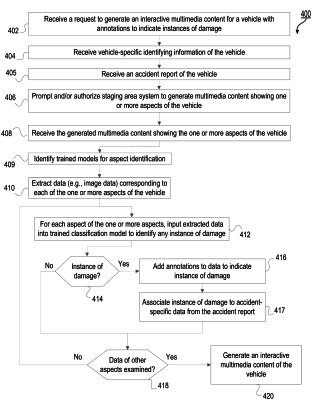| CPC G06F 16/41 (2019.01) [G06F 16/45 (2019.01); G06F 16/48 (2019.01); G06F 18/2413 (2023.01); G06N 20/00 (2019.01); G06V 10/764 (2022.01)] | 20 Claims |

|
1. A method comprising:
receiving vehicle-specific identifying information corresponding to a vehicle;
determining image data corresponding to one or more aspects of the vehicle;
determining, using a trained classification model, one or more instances of damage to the one or more aspects;
annotating, based on the one or more instances of damage, the image data corresponding to the one or more aspects to reflect an indication of the one or more instances of damage;
receiving an input comprising further vehicle-specific information associated with the one or more instances of damage;
receiving, for each of one or more aspects of a plurality of reference vehicles, training data comprising:
multimedia content showing the one or more aspects of the plurality of reference vehicles, and
an identification of image data of the multimedia content corresponding to the one or more aspects of the plurality of reference vehicles;
training a machine learning model by learning recognition of the image data corresponding to each of the one or more aspects from the received multimedia content;
storing the trained machine learning model;
generating, using the trained machine learning model, an interactive multimedia content associated with the vehicle, wherein the interactive multimedia content comprises the annotated image data indicating the one or more instances of damage and the further vehicle-specific information associated with the one or more instances of damage; and
causing, through a user interface and responsive to a request, display of the interactive multimedia content of the vehicle.
|